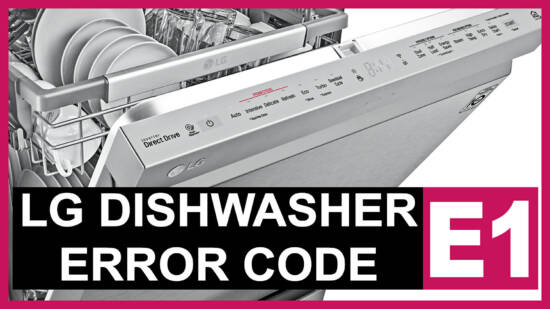An E1 error code, programmed in the LG dishwasher, means that your appliance is leaking. This one is absolutely identical to an AE error code. Why two identical codes of errors, you ask? It is complicated to answer this question unequivocally. Apparently, one of the codes appears in old LG dishwasher models, and the other one shows up in modern devices. However, you need to look for water leakage and figure out the causes of the issue.

Externally, a user may not notice water flow. But there is a special tray under the dishwasher with a built-in float or a water sensor. If there is a leak, water accumulates in this pan and raises the float to the top, which closes the contacts. Therefore, the sensor sends a signal to the control board about the flow of the LG dishwasher. Thus, the E1 error code shows up. This system is also called Aquastop – the leakage protection system.
What you need to check first when the E1 error code appears in the LG dishwasher
There many reasons for water leakage. The problem may refer to the following ones:
- Improper installation of the dishwasher (level and hose)
- Dishwasher door leaking
- Serviceability of the protection against leaks
- Connections of all branch pipes
- Tank burst
- Circulation pumpset, pump, and many other items.
So, to boil it all down, you need to understand where the flow has formed and how to eliminate it.
Eliminating dishwasher door leaking
Water leakage from under the dishwasher door is the most common problem. Hopefully, it is easily removable like the E1 error code. To do this, open the door and manually tear off the old sealing gum along the perimeter of the appliance. Then, take a new sealing gum, suitable for a specific model of the LG dishwasher. With your hands, insert the material in the place from which you pulled the old one. Move around the perimeter of the dishwasher carefully. If the seal is too long, cut it with scissors.
In addition to the seal around the perimeter of the device, there is also a seal at the door bottom.
How to replace it:
- Open the door and unscrew the bolts around the perimeter.
- Close the door and remove the front panel.
- Next, open the door and remove the bottom basket for dishes, so as not to interfere. Using tweezers, gently pull the sealing gum at the door bottom.
- Then take a new seal and insert it so that the end strictly coincides with the edge of the tank. Then insert the seal to the door completely. Make sure that it fits well into the groove, and then screw the panel to the door.
Hoses and pipes checking
One of the probable causes of water leaking into the LG dishwasher tray are clogged sewers and drainage systems. That is why it is necessary to regularly check and clean the filters and hoses from leftover food. It’s not complicated to rinse a filter, installed at the tank bottom. Remove the fine mesh, unscrew the glass and rinse the part under running water.
To check hose tightness and connections of pipes, you have to look inside. To do this, turn the dishwasher upside down and remove the pan that is usually mounted on the bolts in the front of the latch. Under the tray, you will see the “insides” of the device. Check how tightly the hoses are connected to the parts and, if necessary, replace the connecting clamps or the nozzles. Even a simple drop can turn into a jet when a dishwasher is on. Such a situation might cause the E1 error code in the LG dishwasher.
Valve, water sensor
Checking the nozzles, inspect the filler valve. If there are rust marks on it, so this is the first sign to replace the part.
As for the water level sensor, it is located on the pallet, in the same place where Aquastop, the leak protection system, is installed. In the case of water leakage, the valve either fails or screws up. The water level signal is not delivered to the control board. Accordingly, the pump does not start, and the Aquastop protection triggers. If there is a lot of water, it flows from the pallet to the floor. Replace the sensor to eliminate the trouble.
What to do if the tank has burst?
In rare situations, a leak occurs when a plastic tank bursts inside the dishwasher. It may happen if the appliance has served a very long time, or there is a manufacturing defect. In such cases, problem elimination turns into buying a new dishwasher, since repairs can be very expensive. Detecting the crack is difficult. But having found and brewed it, you will save a lot of money.